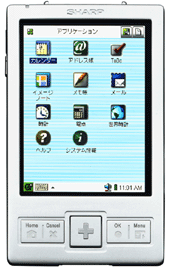Device Profile: Sharp’s Zaurus SL-A300 Personal Mobile Tool
Oct 18, 2002 — by LinuxDevices Staff — from the LinuxDevices Archive — 16 viewsSharp Corporation introduced the Zaurus SL-A300 Personal Mobile Tool into the Japanese market in June, 2002. This new model is said to offer enhanced compatibility with PCs, and is claimed to be the world's smallest and lightest PDA among QVGA color LCD-equipped handhelds (as of June 24, 2002).
New functions in the SL-A300 (relative to the previously introduced SL-5500) include: the Zaurus Shot function, which is described as “letting users instantly transfer data exactly as it appears on their PC screens, just like taking a screen shot”; and the Zaurus Drive function, which allows users to use the SL-A300 as an external storage device for their PC through a USB connection.
Additionally, the SL-A300 is significantly smaller and lighter than the SL-5500 — but lacks the built-in CompactFlash slot of the SL-5500.
 Here is a summary of the features and specifications of the SL-A300 Zaurus PDA . . .
Here is a summary of the features and specifications of the SL-A300 Zaurus PDA . . .
Hardware:
- CPU — 200 MHz Intel PXA210 XScale processor
- Main memory — 64 MB SDRAM (user area approx. 23 MB)
- Display — 3.5-inch reflective TFT LCD with front light, 240 x 320 pixels, 65,536 colors
- Connectors and jacks:
- I/O port
- Stereo headphone jack
- Communication adapter connector
- IR communication port (IrDA, 115 kbps)
- Audio — internal speaker
- Card slot — SD
- Text input method — stylus with handwriting recognition, 50-kana input, QWERTY keyboard, numeric input, symbol input, code input
- Power:
- source — 3.7 V DC, lithium-ion rechargeable battery
- Operating time — continuous display: approx. 12 hours
- Power consumption 1.1W
- Mechanical:
- External dimensions (W x D x H) — approx. 2.7 x 4.4 x 0.5 in. (not including protruding part of display cover)
- Weight — approx. 4.2 oz (without display cover, with stylus; display cover adds 0.6 oz)
- Accessories — AC power adapter (EA-65); stylus; LCD protective cover; USB adapter; USB cable; software on CDROM; documentation.
Software:
- Software platform
- Operating system — Lineo/Embedix Linux
- Java virtual machine — Insignia Geode
- Graphical environment — Trolltech Qtopia
- Built-in applications:
- PIM (Personal Information Management) suite — address book, scheduler, todo list
- Picture viewer, memo pad (text file view/edit)
- Email client (presumably the Qtopia email client)
- Browser (presumably the Opera embedded browser)
- Character set used — 6,879 in total (2,965 JIS level 1 characters, 3,390 JIS level 2 characters, 524 non-kanji characters)
- Built-in dictionary — approx. 210,000 entries (including personal and place names)
- Handwriting recognition characters — 4,082 (2,965 JIS level 1 characters, 722 JIS level 2 characters, 395 non-kanji characters)
- Utilities — file manager, system clock, calculator, world clock, help, system information, data transfer, audio setup, backup/restore, screen design setup, key setup, password setup, IR reception, light/power save setup, PC link setup, software install/delete, date/time setup, touch-screen adjustments
- Office suite — Hancom Mobile Office (MS Word, Excel compatible)
- PC companion software — Zaurus Shot function, Zaurus Drive function (includes backup/restore), Intellisync (synchronization with MS Outlook and Palm Desktop)
This article was originally published on LinuxDevices.com and has been donated to the open source community by QuinStreet Inc. Please visit LinuxToday.com for up-to-date news and articles about Linux and open source.